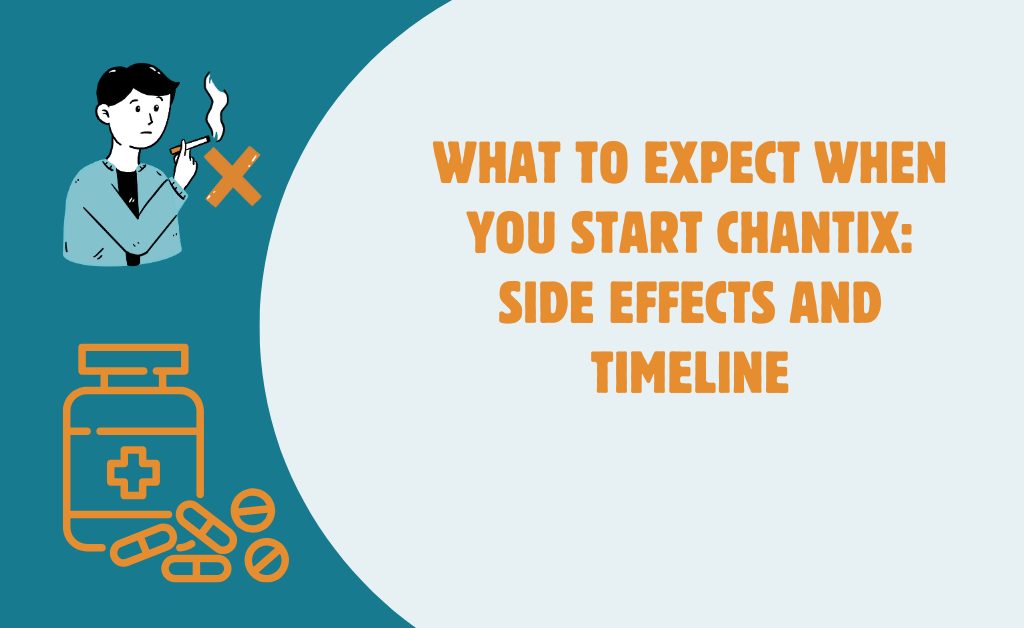Quitting smoking is one of the most difficult but also one of the healthiest choices you can make for your health. Prescription drugs can give many people the advantage they need to overcome their nicotine addiction.
One such drug that is successful in aiding smokers in quitting is Chantix (varenicline). Like any drug, it’s crucial to understand the potential Chantix side effects as well as the course of treatment.
In this section, we’ll cover everything you need to know about starting Chantix, including how it works, Chantix side effects, and the timeframe you should anticipate while your body becomes used to the drug.
What is Chantix and how does it work?
A prescription drug called Chantix (generic name: varenicline) is used to help individuals quit smoking. It functions by precisely targeting the α4β2 nicotinic acetylcholine receptors, which are the same in the brain that nicotine binds to.
As a partial agonist, Chantix partially stimulates these receptors to reduce cravings and withdrawal symptoms. If a person smokes while taking Chantix, it also prevents nicotine from binding to these receptors.
It works on a dual mechanism:
- It assists individuals with nicotine withdrawal by mimicking certain effects of nicotine.
- stops nicotine from completely engaging the receptors, which reduces the ill effects of smoking.
Therefore, Chantix makes it easier for people to stop smoking by reducing the desire to smoke as well as the pleasure that comes from smoking. This is how Chantix works.
When You First Start Chantix: What to Expect
When you know what to expect with the outcome, your transition can turn out to be easier. Starting Chantix can feel like a huge step toward quitting smoking. You will start with a low dosage over the first several days to give your body time to acclimate.
It’s normal to continue smoking during this period because Chantix works to reduce the effects of nicotine, which makes cigarettes less pleasurable as the drug accumulates in your body.
Most people choose a quit date and give up smoking entirely by Day 8. It is anticipated that Chantix will be at its peak brain activity at this point, reducing cravings and alleviating withdrawal symptoms.
However, some people also start to experience adverse effects during this phase; the most commonly reported ones include headaches, nausea, sleeplessness, and vivid dreams.
The key is early consistency. Follow your doctor’s instructions, take your medication as directed, and seek help when you need it. Your chances of success are significantly increased if you can get through the crucial first few weeks.
Chantix Side Effects: A Full Breakthrough
Even though Chantix is well tolerated by many people, it’s crucial to be aware of the potential Side Effects. The following are the Chantix side effects that are most commonly reported:
- Feeling Nausea
- Sleeplessness
- Vivid Dreams
- Headache
- Gas and Constipation
Serious (less frequent) side effects of Chantix There are some rare, occurring severe side effects to be mindful of; however, they are uncommon:
- Behavioral and emotional shifts.
- Minimal chance of cardiovascular problems.
- Allergic reactions include a rash, swelling, or trouble breathing, in which case you should get medical help right away.
Chantix Timeline: How Long Does It Take to Work
Usually used for 12 weeks, Chantix may be extended to 24 weeks by your doctor if needed. The timeline typically looks like this:
- Week 1: Preparation Phase Dosage: To reduce adverse effects, you will begin with a low dosage. From Day 1–3, the dosage may be once a day, 0.5 mg; however, by Day 4–7, it can be increased to thrice daily, 0.5 mg. During the first week, when the drug accumulates in your system, you will continue to smoke. It is anticipated that you will establish a “quit date” for the second week. During this time, some people have vivid nightmares, slight nausea, or difficulty falling asleep. Cravings may not go away right away.
- Week 2: The Week of Quitting: The typical dosage is 1 mg taken twice a day. During this week, most individuals attempt to quit smoking, and they may notice a reduction in cravings and withdrawal symptoms. Initial indications are that your ability to refrain from smoking has improved. Side effects like nausea and sleepiness from Chantix may become more apparent.
- Weeks 3–4: Time for Adjustment Remaining Smoke-Free: The emphasis is on controlling triggers and strengthening new behaviors. The majority of side effects peak here and may progressively become better. Feeling nausea, sleeplessness, headache, vivid dreams, gas, or constipation can be prominently seen. It’s critical to keep an eye out for behavioral or emotional shifts. Although it is uncommon, some people suffer from anxiety or sadness. Always let your healthcare practitioner know about these symptoms.
- Weeks 5–8: Phase of Stabilization: Your body gets used to the medication. It becomes easier to control cravings. The side effects of Chantix typically reduce in severity. Although cravings to smoke may occasionally arise, they are usually simpler to resist.
- Weeks 9–12: Upkeep and Transition: The typical treatment period ends at this point. By now, the majority of individuals are smoke-free. There should be few or no side effects. Depending on your progress, your doctor will decide whether to continue for an additional 12 weeks.
Tips To Manage Side Effects While Using Chantix
Preventing or easily controlling side effects can enable you to take the medication for as long as necessary to get the maximum benefits. Here are some key points to take care of to avoid side effects:
- Always try to take medication with food and water to prevent nausea.
- To ensure that your body gets sufficient time to gradually acclimate to the medicine, pay strict attention to your dose schedule. Do not skip the dose as prescribed.
- Engage in regular exercise to improve mood and sleep quality.
- If side effects are making it difficult for you to go about your everyday life, discuss with your doctor how to change the dosage.
- Utilize a support network to cope with psychological or emotional symptoms, such as a group, a therapist, or a quitline.
Final Thought: Is Chantix Right for You?
For people who are committed to giving up smoking, Chantix can be an effective aid, particularly for those who haven’t found success with other approaches like nicotine patches, gums, or behavioral therapy alone. Its special mode of action gives you two advantages in your quitting journey: it reduces the pleasure of smoking and the demand for nicotine.
But not everyone is a good fit for Chantix. Before beginning, people should speak with their healthcare professional if they have a history of kidney issues or mental health issues or are taking any particular drugs. Although frequent, side symptoms like nausea and sleep problems are typically tolerable. Rarely, mood-related problems or behavioral abnormalities may occur; these should be reported right away to a physician.
In the end, your smoking history, health, and level of commitment to quitting should all be taken into consideration when choosing to use Chantix. Chantix has assisted numerous individuals in achieving long-term success in quitting smoking when combined with a strong support network and motivation. Take the first bold step toward a healthier, smoke-free life by discussing with your doctor if Chantix is right for you.
FAQs:
How long do Chantix side effects last?
As your body adjusts, Chantix side effects often go away in a few days to weeks, although occasionally they could last the entire course of treatment or end when the drug is stopped.
Does Chantix cause depression or mood changes?
Indeed, some people may experience depression or mood swings as a result of using Chantix; it’s crucial to keep an eye out for signs and get in touch with your doctor if you observe any odd changes in behavior or mood.
Can I quit smoking immediately after starting Chantix?
No, after taking Chantix, you normally keep smoking for the first seven days and then schedule your quit date for the second week, which is usually Day 8.
Can I take Chantix with other medications?
Yes, Chantix can be taken with a number of different medications. However, to prevent any possible problems, it’s crucial to let your doctor know about all of your current prescriptions and supplements.
Is it normal to have vivid dreams on Chantix?
Having vivid nightmares is a typical adverse effect of Chantix. As your body gets used to the drug, the symptoms usually get less severe over time. See your doctor if they are persistent or get worrisome.
References:
- Varenicline (Chantix): Uses, Side Effects, Interactions, Pictures, Warnings & Dosing – WebMD
- Varenicline: Uses, Dosage, Side Effects, Warnings – Drugs.com
For more informative blogs, click here


